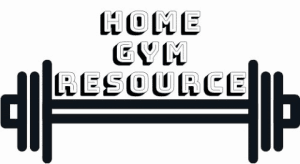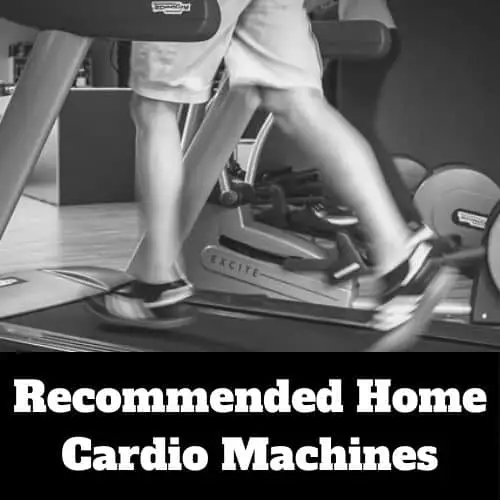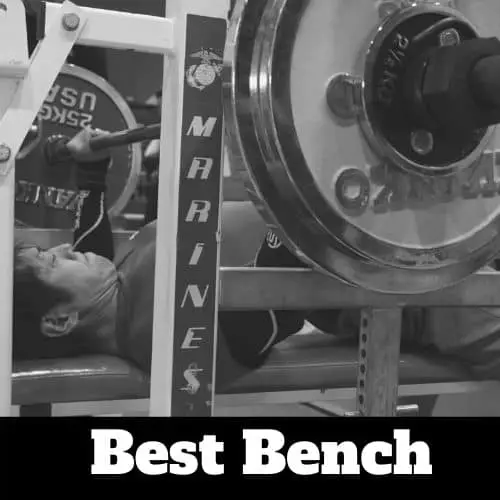A commercial gym has a ton of machines that just have a single purpose. How can you reproduce the same movements in your home gym where you can’t have all those different machines?
Most exercises that are often done on separate machines can be done at home with relatively simple equipment. A power rack, barbell, bench, and set of dumbbells allow you to do almost every exercise. A functional trainer can provide all cable exercise options.
Below you can find the specific machines and how you can do them at home with limited equipment. For some exercises, you just need very little equipment while others just need a certain level of equipment to be done right.
Contents
- 1 1. Cardio Machines Home Alternative
- 2 2. Ab Crunch Home Alternative
- 3 3. Lat pull-down Home Alternative
- 4 4. Smith Machine Home Alternative
- 5 5. Seated bench press Machine Home Alternative
- 6 6. Lateral Raise Home Alternative
- 7 7. Seated Bicep curl Home Alternative
- 8 8. Seated Leg Press Home Alternative
- 9 9. Seated Leg Extension Home Alternative
- 10 10. Assisted Pull-up/Dip Machine Home Alternative
- 11 11. Seated Calf Raise Home Alternative
- 12 12. Pec deck
- 13 13. Seated Back Extension Home Alternative
- 14 14. Seated Row Home Alternative
- 15 Difference Between Machines And Free Weights
1. Cardio Machines Home Alternative
Cardio machines in all shapes and forms are by far the most used pieces of equipment in commercial gyms. Treadmills, ellipticals, bikes, rowers, and more are always the pieces of equipment that see a lot of use. These machines don’t necessarily target specific muscles but aim to improve your cardiovascular health.
Improving your cardiovascular health is all about keeping your heart rate elevated for an extended period. There are tons of ways you can accomplish this even without any equipment. Getting your heart rate elevated isn’t very difficult. Just do a set of heavy deadlifts and it’s going to be pretty high. The trick is to find something you can do for 30 minutes or more without your muscles giving out.
Suggested post: The best alternatives to elliptical trainers
Doing deadlifts for 30 minutes straight isn’t very practical. Even at a very light weight, it’s going to be very difficult and there is a high chance your form will break down.
So what can you do that;
- Gets your heart rate up
- Is easy to adjust
- Isn’t dangerous when your form breaks down.
- Can be done for 30+ minutes.
Cardio machines do make adherence to a program a bit easier and make it easier to track your progress since timers and resistance levels are all built-in. If doing cardio inside at home is important to you, getting some type of cardio machine could be a good idea.
Home gym alternative
The best alternative is a kind of HIIT approach. You go hard for about a minute and get your heart rate up to close to your maximum. Then take a break and let your heart rate come down to about 120 BPM. Then go again for a minute. This way your heart rate will stay high for a longer period but your muscles have a bit of time to recover for the next ‘set’. The best exercises to do this with;
- Kettlebell swings
- Burpees
- Jumping jacks
- Farmers walk
And of course, you don’t have to pick one. You can rotate through them however you like. To make sure your heart rate doesn’t go very low or high, you can use a heart rate monitor that goes on your wrist like a Fitbit or similar.
2. Ab Crunch Home Alternative
I wrote this in January. The commercial gyms are full of people hogging the ab crunch machines in search of those elusive 6-pack abs. Doing crunches might not be the best way to go about getting visible abs in the first place but there are also quite a few exercises that can easily replace these machines.
Crunches are not great for your lower back since they put a lot of pressure on your spinal discs.
What else can you do?
Home gym alternative
- Hanging leg/knee raises
- Plank crunch
- Mountain climbers
- Leg raise
Those are just the alternatives. There are a ton of ab exercises you can do, the ones listed above are effective but also much better for your lower back.
Another great alternative that requires an extra piece of equipment is Swiss ball exercises. Ab exercises with a Swiss ball are proven to activate a lot of ab musculature.

3. Lat pull-down Home Alternative
Although many newcomers in the gym completely forget to train their back, the lat pull-down is still a very popular exercise. The lat pull-down has a bar or handles above your head which you have to pull down. This targets your back muscles and especially your Latismus Dorsi in a different way than rows for example.
It’s a great exercise but most people don’t have a lat pull-down machine in their home gym so what can you do?
Home gym alternative
In short, pull-ups are the closest alternative. Most people will already have a pull up bar in their home gym and the movement pattern is the same although it’s slightly more difficult to get your form correct. If pull-ups are too light, adding weight with a belt is easy enough. If pull-ups are too heavy, you can use a resistance band to make them lighter.
Alternatively, you can add a pulley and cable system to your power rack to really mimic the same setup as a lat pull-down. You can use a normal bench as the seat although you’d miss the thigh support that prevents you from lifting off.

4. Smith Machine Home Alternative
A Smith machine is a barbell that is attached to two rails. It looks like a barbell in a power rack but it can only go up and down. Many people like to do bench presses and squats on this machine. Even if this machine is available maybe you shouldn’t use it.
Anything you want to do with a Smith machine is possible to do with a free barbell. In most cases, it will actually be better to use the free barbell. A Smith machine might seem like it would correct your form if you did an exercise wrong. That’s not the case. It actually covers up your bad form since the bar on a Smith machine can only go up or down. This can make you think you’re doing squats or deadlifts correctly while you aren’t. This raises the injury risk in the long run.
Also, once you switch from the Smith machine to a free barbell, you’ll notice you have some form problems or muscle imbalances you didn’t notice before.
Home gym alternative
- Free barbell exercises; Squat, deadlift, overhead press, etc.
Take some time to perfect your form, especially on the squat and deadlift. On those lifts your form is really important to prevent injuries.
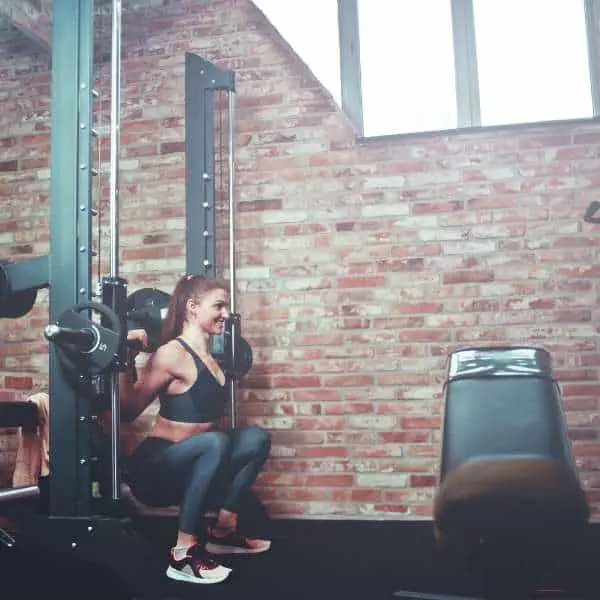
5. Seated bench press Machine Home Alternative
Many people opt for the seated bench press machine. You sit down and push the weight forward, simple. It mimics the movement of a ‘real’ bench press. Most versions of this type of machine are actually pretty good. While a barbell bench press with free weights might be a bit better at building strength, the machine version is a great accessory movement for building muscle since you can safely go to failure.
The barbell bench press would be a really obvious alternative. Most home gyms will have the necessary equipment to perform it properly. The barbell bench press doesn’t seem like a perfect alternative though. Bench press machines are often unilateral machines which means that your arms move separately and move different weights.
That means the dumbbell bench press is a much better alternative. Since you use two dumbbells, one arm moves one dumbbell which is much closer to the machine. While you might be able to lift less weight than with a barbell, the dumbbells mean both arms/pecs are forced to do the same amount of work. This reduces the risk of muscle imbalances.
That’s not to say you shouldn’t do the barbell bench press. It’s still an awesome lift, just not the perfect alternative.
Home gym alternative
- Dumbell bench press
- Incline DB bench press
6. Lateral Raise Home Alternative
A machine that targets your shoulders by having you move your arms from next to your body to a 90-degree angle. There’s a pad on your upper arms that provides resistance. It’s a very effective movement to train your shoulders and give you a wider look. Personally, I’ve never had much luck with these machines since they don’t fit me properly. The pad would move around uncomfortably on my arms and distract me from the exercise.
Exercising your shoulders with free weights is a much better option for most people. There are a lot of options and it’s best to use a combination of these exercises for the best results.
Home gym alternatives
- DB lateral raise
- DB shoulder press
- Seated DB shoulder press
- Barbell overhead press
The Dumbbell lateral raise is the exact same movement as the machine but for complete shoulder development, it’s better to do at least one pressing variation as well.
7. Seated Bicep curl Home Alternative
No gym session is complete without getting a good pump in your biceps. It’s just the law. You can see people using a selectorized bicep curl machine to train their biceps daily. The interesting thing about those machines is that usually, the elbow is fixed in place since they’re supported by a pad. That allows you to really isolate the biceps. Other bicep exercises require more mind-muscle connection to get the same degree of muscle isolation and will require the use of more stabilizing muscles.
A heavy barbell curl for example will require you to use a lot of back and ab muscles as well as your biceps.
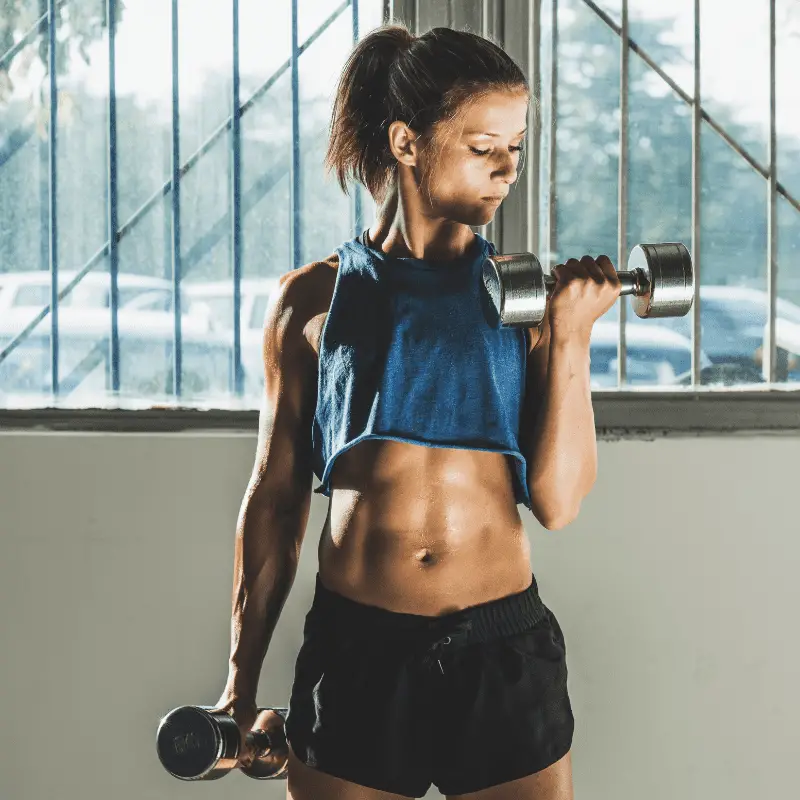
Home gym alternative
So while the barbell curl is a great bicep builder, it isn’t an exact alternative for the seated bicep curl.
There are two exercises that are much better matches;
- Preacher curls (on an incline bench). The preacher curl is usually done on a dedicated piece of equipment. This equipment has a seat and a diagonal pad where you can rest your elbow and triceps. This is easily recreated with an incline bench. Set the bench at a 45-degree incline and use the top of the backrest to support your elbow. You’ll only be able to do one arm at a time and there’s no seat but the movement is the same.
- Seated incline curl. There is another good option that uses the incline bench. Sit down on the bench and rest against the backrest. Let your arms hang down so they’re behind your body. Then curl from there. In that position, it’s much easier to keep your elbows in the same position and this way your biceps are used in a slightly different position than normal which will give you a new training impulse.
8. Seated Leg Press Home Alternative
Another mainstay of commercial gym circuit training is the leg press. There is a variety of machines and they all look a little different but what you do on it stays the same. Your back is supported on a seat and your legs push the weight away. That means you use most of the muscles of your lower body and a few stabilizing muscles in the upper body like the spinal erectors and the abs.
It doesn’t load the upper body like a barbell squat would. A barbell squat requires quite a bit of static upper body strength to keep a correct posture. Leg presses are a bit safer and require less skill to perform correctly.
Home gym alternative
Of course, the barbell squat is the most obvious alternative to the seated leg press. The BB squat is an amazing exercise that can help you develop a great lower body and real-world strength. As an alternative to a leg press, it’s not perfect, however, because of the involvement of the upper body.
If you can do BB squats and are comfortable with them, you can absolutely do them. If not there are two other alternatives;
- Vertical leg press machine. This type of leg press machine is much smaller, lighter and cheaper than a seated leg press. Click here to find out more about the vertical leg press machine.
- Lunges. You can do lunges with or without weights in your hands depending on your needs. Lunges are not as technical as barbell squats and require a bit less upper-body strength.
9. Seated Leg Extension Home Alternative
The seated leg extension is a machine that isolates the quadriceps muscle.
Unless there are reasons to specifically isolate the quadriceps, you’re probably better off choosing an exercise where you use all your leg muscles at the same time so you create a more functional strength.
Home gym alternative
- Resistance band leg extensions. Attach a band to the rear leg of a chair. Sit on the chair and put your leg through the band. Extend as normal from there.
- Ankle weights leg extensions. Attach weights to your ankles and sit on a chair. Extend as normal from there.
- Barbell squats. Targets quads but also the glutes, hamstrings, and back.
- Lunges.
- Vertical leg press.

10. Assisted Pull-up/Dip Machine Home Alternative
Pull-ups and dips are awesome exercises that build upper body strength and muscle mass. Not everyone can do them without support, however. The goal is to ultimately do them without any assistance but it might take a while before you’re there.
While in many gyms there is a single machine that can do both, in a home gym you’ll have to get a bit more creative to do the same thing.
There are two ways you can go;
- Do pull-ups and dips and use resistance bands for assistance
- Do different exercises that build up the same muscles.
Home gym alternative
Direct alternatives:
- Resistance band assisted pull-ups. Attach a band to the pull-up bar. Grab the bar and step in the band.
- Resistance band-assisted dips. Attach dip handles to your power rack. Attach a band to the pull-up bar. Grab the dip handles and put your feet in the band.
Uses the same muscles:
- Lat pull-down. This is a very close alternative for pull-ups. Check out number 3 for more info.
- Barbell Rows. Builds up your back muscles for the pull-up.
- One arm dumbbell rows. Builds up your back muscles for the pull-up.
- Barbell bench press. Builds up chest and triceps for dips.
- Dumbbell bench press. Builds up chest and triceps.
- Triceps extensions. Builds up triceps
- Dumbbell chest fly. Builds up the chest.
11. Seated Calf Raise Home Alternative
Funny thing about the seated calf raise machine. Most people don’t load them nearly heavy enough. Think about it. In daily life, your calves have to raise your whole body plus whatever you’re carrying. When you sit down but just load the machine with less than your body weight, it’s pretty useless since the machine takes your body weight out of the equation and then you add less weight back in.
If done really heavily, it works but there are better options that don’t require a whole separate machine.
Home gym alternative
- Standing calf raises. You can hold dumbbells in your hands for extra resistance. Find a small ledge to raise up the front of your feet. You can use a thick weight plate for this purpose. Then go through the same range of motion as with the machine.
12. Pec deck
Guys love training their arms, abs, and chest. And there’s nothing wrong with that as long as you don’t completely neglect all other exercises. The pec deck, sometimes known as the butterfly machine is another machine that’s used to build your chest. You stretch out your arms to your sides, grab the handles, and then move your arms to the front of your body while keeping them stretched out.
This isolates the Pectoralis (chest) muscles. In a home gym, it’s a bit difficult to completely isolate the pec without using your arms since they naturally work together.
Home gym alternative
- Dumbbell fly from floor. Dumbbell flies on a bench can be dangerous to your shoulders. Doing them from the floor slightly limits the range of motion but also dramatically lowers the risk of injury. This is the closest alternative to the pec deck.
- Dips.
- Push-ups.
- Dumbbell bench press.
- Incline dumbbell bench press.
- Cable crossover. If you’re lucky enough to have a cable station in your home gym.
13. Seated Back Extension Home Alternative
The lower back is an important part of the body to get and keep strong. Having a strong lower back can prevent nasty injuries. The seated back extension is designed to isolate the spinal erectors that keep you standing straight. You just sit down and there’s a pad that you push back with your back. It’s pretty simple and effective.
There are a lot of exercises that use the same muscles since they’re at the base of your spine and use them for almost everything. Isolating them is a bit more difficult. So while barbell deadlifts and squats hit your spinal erectors pretty hard, that’s not a good alternative since it really doesn’t isolate them.
Home gym alternative
- Superman. Lay belly down flat on the floor. Straighten and tense your legs. Then lift your chest and arms off the floor.
- Resistance band extension. Sit on a hard flat surface. Something stable without a backrest. Then put a resistance band under your feet. Grab the other end of the band with your hands and bring them to your chest while leaning forward. Then extend back while keeping your back straight, pivoting at the hips.
- Kettlebell swings. A simple but not easy exercise you can do for high repetitions.
- Reverse hyper on the table. Lay down with your torso on a table. Lift up your legs until your body is straight. You might have to hold on to the table and make sure it won’t tip over.
14. Seated Row Home Alternative
Seated rows are the machine where you sit on a seat and a pad supports your chest. Then you pull the handles towards you. This exercises your back muscles. The difference with the lat pulldown is that you pull from in front of your body instead of from above. This targets muscles slightly differently.
Home gym alternative
There are a lot of great alternatives for the seated row you can do in your home gym;
- One arm dumbbell row. Put one knee and hand one the bench. The other leg is set back and to the side for stability. With your free arm, grab a dumbbell and pull. Then switch sides when you’re done.
- Bent over row (DB or BB). Stand up straight with a pair of dumbbells or barbell in your hands. Bend over until your back is parallel to the floor. Then pull and try to get your hands next to your body.
- Chest supported row. Lay down face down on an incline bench. Hold a pair of dumbbells in your hands and pull them to the sides of your body. You can try it with a flat bench but your arms are probably too long to get a full range of motion. For a flat option, the one armed DB row is better.
- Inverted row. Put a barbell on the safety pins of a power rack and wedge it into a corner between the safety pins and power rack post. Then get into a position that could best be explained as an inverted plank. From there pull yourself closer to the bar.
Those are some of the best rowing options you can do with a barbell or set of dumbbells in your home gym. There are many more variations so feel free to try and experiment.

Difference Between Machines And Free Weights
As you can see above, most of the best alternatives for gym machines are free weights. What’s the difference between training with machines vs. free weights?
There are pros and cons to both types of exercise. Even though the movement might be the same, there are some key differences.
Set movement pattern
Machines have a movement pattern that has been decided by the person that designed the machine. You grab the handles of the machine and there is only one way it can move. There is no way the machine will deviate from that set path.
Sure, some machines can be adjusted but that doesn’t change that the movement pattern is set. The benefit of that is that it’s very safe for most people. There are no weights that can drop on your head or anywhere else on your body. You’re very likely to target the correct muscles that the machine is designed to target. Because of the safety, you can overload the exercise easily and safely. More weight and repetitions means bigger muscles in general.
Now while the set movement pattern might be good for the average person, it’s not for everyone. Some people are just too small or big for the machines and the movement just doesn’t fit them.
Cover up bad form
One issue that can be bigger with using machines than when using free weights is the unintended use of muscles. Sure, it’s quite difficult to completely isolate a single muscle and you’ll almost always have to use other muscles when lifting some kind of weight.
But with machines you can possibly use some unintended muscles in the wrong way. IF you’re just focused on moving the handles and there is only one way a machine can move, it’s sometimes possible to substitute stronger muscles to take the load of the intended muscle.
Stabilizing muscles
Another difference is the use of the stabilizing muscles. Around the main muscle there are often a lot of smaller muscles. These muscles aren’t directly used to move the weight but are still necessary. Usually they stabilize your joints so your shoulder doesn’t pop out of its socket for example.
With free weights, the bar or dumbbell can go in many more directions than with a machine. That means those small muscles have to pay attention and do more to keep the weight from straying from the intended path. This means you have to use them more and they will develop along with the main muscles. That will also mean that training with free weight will translate into real world strength much better.
Injury risk
Regarding injuries it’s a bit of a mixed bag. Anytime you move you could possibly injure yourself. Some movements and types of exercise have a higher risk of injury than others. So how does the injury risk of using machines compare to free weights?
In general, machines don’t load your stabilizing muscles like free weights do. That means you don’t train them. Let’s say you suddenly want to lift a real world weight. This real world weight isn’t on a set path which means it can go in many more directions. Your main muscles might be perfectly able to lift the weight. However the stabilizing muscles are underdeveloped so when something goes wrong an you suddenly have to use them, it’s much easier to injure them.
Generalizing, free weights have a higher injury risk while using them while machines can create muscles imbalances that can lead to injuries down the road. Of course it also depends on the specific exercise.
Equipment
Of course another huge difference is the amount of equipment necessary. The alternatives listed above can be done in a home gym with fairly simple equipment. Just five or six pieces of equipment and you can train your whole body.
While gym often just train one muscle. That means you need a different machine for every muscle. This takes up a ton of space and is very expensive.
